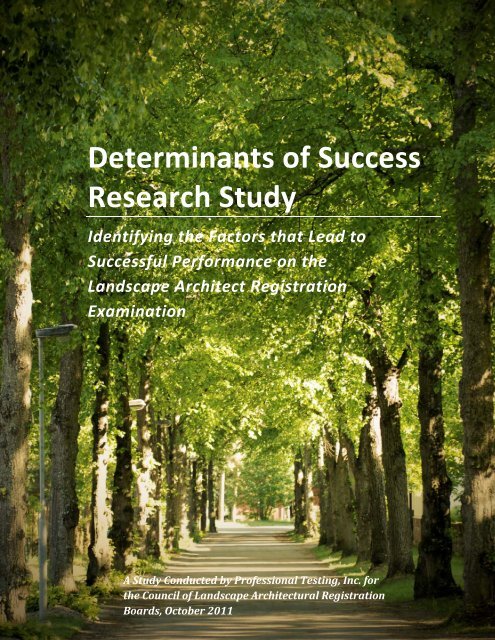Determinants-of-Success-Report-Final-Report-Executive-Summary-footnotes
Determinants-of-Success-Report-Final-Report-Executive-Summary-footnotes
Determinants-of-Success-Report-Final-Report-Executive-Summary-footnotes
Create successful ePaper yourself
Turn your PDF publications into a flip-book with our unique Google optimized e-Paper software.
<strong>Determinants</strong> <strong>of</strong> <strong>Success</strong><br />
Research Study<br />
Identifying the Factors that Lead to<br />
<strong>Success</strong>ful Performance on the<br />
Landscape Architect Registration<br />
Examination<br />
A Study Conducted by Pr<strong>of</strong>essional Testing, Inc. for<br />
the Council <strong>of</strong> Landscape Architectural Registration<br />
Boards, October 2011
Prepared by:<br />
Adrienne W. Cadle, M.Ed.<br />
Dr. Corina M. Owens<br />
Pr<strong>of</strong>essional Testing, Inc.<br />
7680 Universal Boulevard, Suite 300<br />
Orlando, Florida 32819<br />
Phone: (407) 264‐2993<br />
Fax: (407) 264‐2855<br />
http://www.pr<strong>of</strong>testing.com<br />
Page 1
EXECUTIVE SUMMARY<br />
Purpose <strong>of</strong> the Project<br />
At this time, there is a lack <strong>of</strong> quantitative/qualitative data that identifies the<br />
determinants <strong>of</strong> candidate success on the Landscape Architect Registration<br />
Examination (L.A.R.E). The principal goal <strong>of</strong> the research project is to define and, if<br />
possible, weigh the determinants for success on the L.A.R.E. and to provide greater<br />
insights for the pr<strong>of</strong>ession and regulatory community on which to base policy,<br />
practice, and support decisions.<br />
Research Methods<br />
This study consisted <strong>of</strong> three phases. During the first phase, the research team<br />
interviewed members <strong>of</strong> three specific stakeholder groups via telephone. The<br />
results <strong>of</strong> the phone interviews were used to develop the survey in phase two <strong>of</strong> the<br />
study. The survey was administered after four separate administrations <strong>of</strong> the<br />
L.A.R.E. over the course <strong>of</strong> one year. The final stage <strong>of</strong> the study was the statistical<br />
analysis, whereby the data collected from the electronic survey was analyzed to<br />
determine what factors best predict successful performance on the L.A.R.E.<br />
Overall, five statistical models were analyzed based on the five areas that were<br />
identified as contributing to successful performance on the L.A.R.E.: Education<br />
Factors, Work Experience Factors, Preparation Factors, Skills Factors, and Testing<br />
Environment Factors<br />
Key Findings<br />
Education and work experience factors seemed to have the greatest impact on<br />
candidates’ performance on the L.A.R.E. Preparation and skills factors contributed<br />
to successful performance on some <strong>of</strong> the exams, while testing environment factors<br />
had little to no impact on candidates’ performance.<br />
Education Factors<br />
The level <strong>of</strong> education obtained by exam candidates positively impacted both<br />
Sections A and B <strong>of</strong> the L.A.R.E. The higher the level <strong>of</strong> education obtained by exam<br />
candidates, the better they did on the Section A and B exams.<br />
Page 2
For the Section C exam, those who obtained a degree from a program accredited by<br />
the Landscape Architectural Accreditation Board (LAAB) or the Canadian Society <strong>of</strong><br />
Landscape Architects* (CSLA) scored much higher (on average, 212.98 points higher)<br />
than those who obtained a degree from a nonaccredited program.<br />
Candidates who took college courses in Planting Design or History <strong>of</strong> Landscape<br />
Architecture scored higher on the Section E exam.<br />
Work Experience Factors<br />
Work experience factors contributed to successful performance on all but the<br />
Section C exam. The number <strong>of</strong> years spent working in landscape architecture had a<br />
negative impact on both the Section A and B exams, indicating that the longer one<br />
waited to take the Section A or B exams after graduation, the lower the performance<br />
on those two exams.<br />
Diversified work experience contributes positively to successful performance on the<br />
L.A.R.E. Experience in stormwater management and governmental work experience<br />
had a positive impact on the Section A exam, experience in planting design had a<br />
positive impact on the Section B exam, experience in institutional projects had a<br />
positive impact on the Section D exam, and experience in large‐scale residential and<br />
land planning had a positive impact on the Section E exam.<br />
Preparation Factors<br />
Sections A, C, and E were impacted by preparation factors. Candidates who studied<br />
alone were more successful on the Section A exam, and candidates who split their<br />
time studying both alone and in groups performed better on the Section C exam.<br />
Those who utilized the ASLA practice problems** scored higher on the Section C exam<br />
than those who did not utilize the ASLA practice problems. Lastly, the longer the<br />
amount <strong>of</strong> time spent studying, the better the performance was on the Section E<br />
exam. For every one month increase in time spent studying, exam candidates<br />
scored on average 69.56 points higher.<br />
Page 3
Skills Factors<br />
In terms <strong>of</strong> perceived skill, those who considered themselves “technical thinkers”<br />
scored higher on both the Section B and D exams. Those who identified themselves<br />
as having good spatial reasoning skills performed higher on the Section B and E<br />
exams. More time spent drawing on a computer had a positive impact on the<br />
Section C exam, while more time spent designing by hand had a positive impact on<br />
the Section E exam.<br />
Key Takeaway<br />
Based on the findings <strong>of</strong> this study, candidates should consider the following<br />
actions to optimize their performance on the L.A.R.E.:<br />
<br />
<br />
<br />
<br />
<br />
<br />
Obtaining a landscape architecture degree from an LAAB‐ or CSLAaccredited<br />
institution.<br />
Taking the L.A.R.E. closer to college graduation rather than waiting to gain<br />
more years <strong>of</strong> experience in landscape architecture.<br />
Gaining diversified experience in the years spent working in landscape<br />
architecture.<br />
Increasing study time both alone and in groups.<br />
Utilizing the ASLA practice problems.<br />
Spending time drawing on a computer, but designing by hand.<br />
For more information, please contact the Council <strong>of</strong> Landscape Architectural<br />
Registration Boards at 571‐432‐0332 or info@clarb.org.<br />
Page 4


